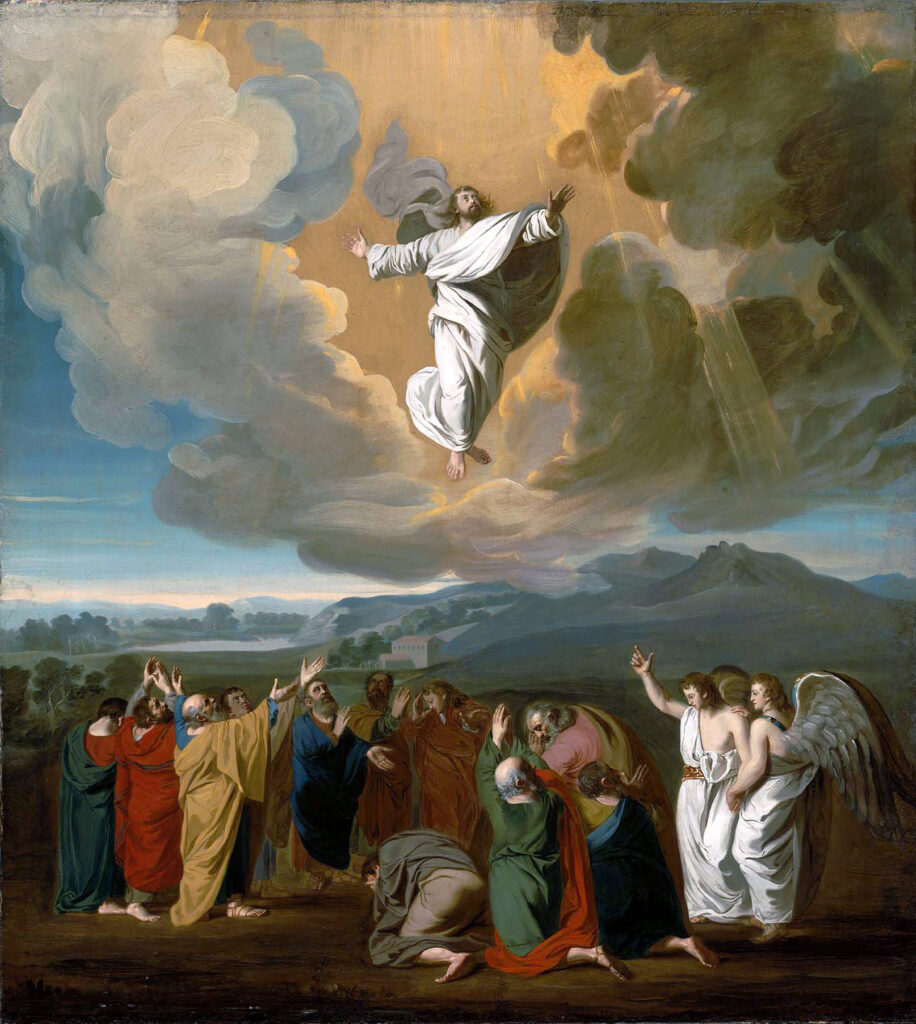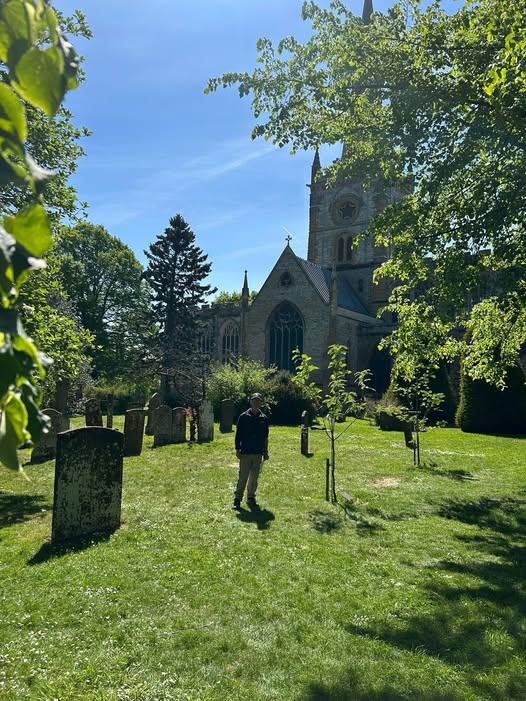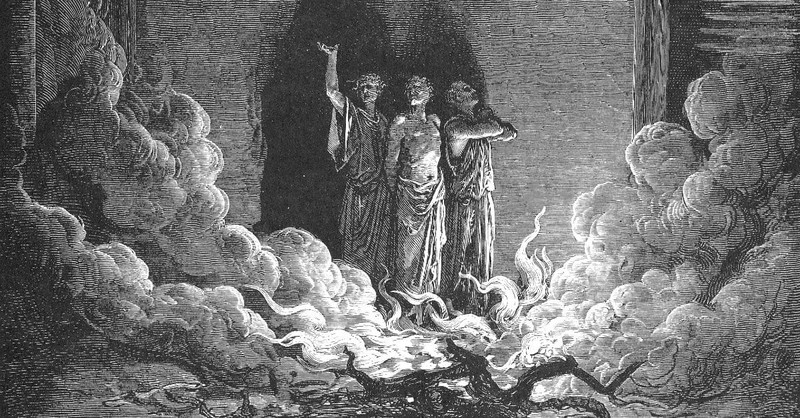* * * *

* * * *
May 31, 2025 – The last post said the next major feast days are Ascension Day – this year Thursday, May 29 – and two days later the Visitation of the Blessed Virgin. (Mary’s visit to the expectant mother of John the Baptist.) And that this post would cover those two feasts, so here goes.
First off, Ascension Day always comes on a Thursday, 40 days after Easter. It’s a major Feast, and it’s ecumenical. (“Universally celebrated.”) More precisely, it’s celebrated on the 40th day of Eastertide, the 50-day church season running from Easter Day to Pentecost Sunday. And in terms of importance it ranks up there with the Passion, Easter, and Pentecost.
The standard Gospel reading for the day, Luke 24:44-53, tells the story:
Jesus said to his disciples, “These are my words that I spoke to you while I was still with you… Then he opened their minds to understand the scriptures, and he said to them, “Thus it is written, that the Messiah is to suffer and to rise from the dead on the third day…” Then he led them out as far as Bethany, and, lifting up his hands, he blessed them. While he was blessing them, he withdrew from them and was carried up into heaven…
Note the words saying Jesus “opened their minds to understand the scriptures,” followed by words that the disciples “returned to Jerusalem with great joy.” (That’s the euaggelion, the Good News!) I found two good articles on the subject. The first, Why Does the Ascension of Jesus Matter? – BibleProject, says that we as Christians are “invited to ascend into this way of living,” that is, ascend to where the “followers of Jesus become the place in the world where Heaven and Earth overlap.” (Emphasis added.) The second, The Ascension of Jesus – What was the Meaning and Significance, said the event was the “climatic, crowning event of [Jesus’] exaltation, and the necessary precursor to his continuing work through the Spirit and the church.”
Then too there’s the Wikipedia article, Ascension of Jesus. It refers to the Apostle’s Creed, which says in part that Jesus “ascended into heaven, and is seated at the right hand of God the Father almighty.” This idea “provided an interpretative frame for Jesus’ followers to make sense of his death and the resurrection appearances.” Or as theologian Justus Knecht wrote:
Our Lord went up Body and Soul into heaven in the sight of His apostles, by His own power, to take possession of His glory, and to be our Advocate and Mediator in heaven with the Father. He ascended as Man, as Head of the redeemed, and has prepared a dwelling in heaven for all those who follow in His steps.
In other words, if Jesus hadn’t “ascended to Heaven,” we wouldn’t have a place to stay when we get there. (By faith, expressed in Romans 10:9, “If you declare with your mouth, ‘Jesus is Lord,’ and believe in your heart that God raised him from the dead, you will be saved.” Period.)
Turning to the Visitation, where Mary visited the mother of John the Baptist (this year celebrated Saturday, May 31): It’s discussed in Visitation (Christianity) – Wikipedia:
The Visitation is the visit of Mary with Elizabeth as recorded [in] Luke 1:39–56. It is also the name of a Christian feast day[,] celebrated on 31 May… Mary is pregnant with Jesus and Elizabeth is pregnant with John the Baptist. Mary left Nazareth immediately after the Annunciation and went “into the hill country” [of Judah] to attend to her cousin.
Wikipedia added, “In the Gospel of Luke, the author’s accounts of the Annunciation and Visitation are constructed using eight points of literary parallelism to compare Mary to the Ark of the Covenant.” (Which I didn’t know.) And the Blessed Virgin Mary article added that Elizabeth greeted Mary with the words, “Blessed are you among women, and blessed is the fruit of your womb.” Mary responded with what became known as Magnificat. In turn:
John the Baptist, still unborn, leaped for joy in his mother’s womb. Thus we are shown, side by side, the two women, one seemingly too old to have a child, but destined to bear the last prophet of the Old Covenant … and the other woman, seemingly not ready to have a child, but destined to bear the One Who was Himself the beginning of the New Covenant, the age that would not pass away. (Emphasis added.)
In turn the Magnificat echoes several Old Testament passages, including allusions to “the Song of Hannah,” in 1st Samuel 2:1-10. (Not to mention “the Book of Odes, an ancient liturgical collection,” but not to be confused with the Odes of Solomon.)
Note also that another big feast day is coming up on June 8, the Day of Pentecost, also called Whitsunday. I’ll cover that in the next post, but in the meantime consider this painting of Mary reciting the Magnificat with John the Baptist’s parents “looking on in the background.”
* * * *

* * * *
The upper image is courtesy of the Wikipedia article, Ascension of Jesus, with the full caption: “Jesus’ ascension to heaven depicted by John Singleton Copley, 1775.”
The Book of Common Prayer reference: The “corporate-mystical” prayer is on page 339, the post-communion prayer for Holy Eucharist, Rite I.
Feast days are designated days on the liturgical (church) calendar “set aside to commemorate events, saints, or doctrines that are important in the life of the Church. These can range from Solemnities, which are the highest-ranking feast days like Easter and Christmas, to optional memorials that celebrate lesser-known saints.” Feast Days: Celebrating the Church’s Calendar.
For this post I borrowed from The Visitation – 2016, 2017’s Ascension Day 2017 – “Then He opened their minds,” also Mary’s Visitation – and Pentecost – 2017, and On Ascension Day, 2024. A side note: In the 2024 post I explored the idea of “life after life,” especially “after a grueling event years ago. My nephew was riding in a car, the car plunged into the Chattahoochee River north of Atlanta, and he was trapped inside… That tragic death shook my faith.” Strangely enough – to some anyway – I found comfort in the First law of thermodynamics, which says energy is neither created nor destroyed, it simply changes form. (I came to figure the human soul is a form of energy.) See also On “her spirit returned” – and Ascension Day, from 2023. It explored at greater length such topics as Ensoulment and Jeremiah 1:5, “Before I formed you in the womb I knew you.”
The lower image is courtesy of Mary’s Magnificat James Tissot – Image Results, and more especially Magnificat of Our Lady Painting by James Tissot—A Catholic Commentary. (“Catholic Art Blog[:] The Moment of the Magnificat,” by Patrick Werick (July 21, 2011),” which noted: “French artist and illustrator James Tissot captures the moment the blessed Virgin Mary recites the Magnificat while visiting her relations Elizabeth and Zacharias (notice them looking on in the background):”
Tissot was known for spending time in the Holy Land and painting a plethora of scenes from the life of Jesus Christ. What particularly sets him aside from other artists’ renditions of the life of Christ is his authenticity in displaying accurately the ethnic garb and customs that were in place while Jesus walked the earth.
See also The Magnificat (Le magnificat) – Brooklyn Museum, and James Tissot – Wikipedia.
* * * *
* * * *



